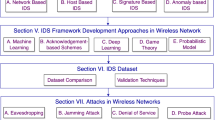Abstract
A new trust model for authentication in ad hoc networks is proposed. The model differentiates between the identity-based and public-key-based trusts for issuing the validity certificates that bind public keys to real-world identifiers. It includes a model for combining these trusts and a technique for computing the public-key-based trust. In this composite trust model, without or with recommendation, a new algorithm for node authentication on the basis of arbitrary graphs of previously issued validity certificates is developed. It is called the validity propagation algorithm and is computationally feasible even for large networks. In general, the proposed method is applicable to any public-key infrastructure, distributed or hierarchical, with or without certification authorities.
Similar content being viewed by others
References
Carreras I., Chlamtac I., Pellegrini F.D., Miorandi D.: BIONETS: bio-inspired networking for pervasive communication environments. IEEE Trans. Veh. Tech. 56(1), 218–229 (2007)
Čapkun S., Buttyán L., Hubaux J.-P.: Self-organized public-key management for mobile ad hoc networks. IEEE Trans. Mobile Comput. 2(1), 52–64 (2003)
Harrigan, M., Healy, P.: Efficiently drawing a significant spanning tree of a directed graph. In: Proceedings of 6th International Asia-Pacific Symposium on Visualization APVIS 2007, pp. 53–59 (2007)
Jøsang A.: A logic for uncertain probabilities. Int. J. Uncertain. Fuzziness Knowl.-Based Syst. 9(3), 279–311 (2001)
Kanchi S., Vineyard D.: An optimal distributed algorithm for all-pairs shortest-path. Int. J. Inf. Theor. Appl. 11(2), 141–146 (2004)
Luo, H., Zerfos, P., Kong, J., Lu, S., Zhang, L.: Self-securing ad-hoc wireless networks. In: Proceedings of ISCC 2002, pp. 567–574 (2002)
Maurer, U.: Modelling a public-key infrastructure. In: Proceedings of ESORICS ’96, Lecture Notes in Computer Science, Vol. 1146, pp. 325–350 (1996)
Moskowitz, R., Nikander, P.: Host identity protocol (HIP) architecture. RFC 4423, IETF (May 2006)
Rivest, R.L., Lampson, B.: SDSI—a simple distributed security infrastructure. Technical report, MIT (1996)
Tarjan R.: Depth-first search and linear graph algorithms. SIAM J. Comput. 1(2), 146–160 (1972)
Zimmermann P.: The Official PGP User’s Guide. MIT Press, Cambridge (1995)
Author information
Authors and Affiliations
Corresponding author
Additional information
This work has been supported by the European Commission within the framework of the BIONETS project ISTFET-SAC-FP6-027748, www.bionets.eu.
Rights and permissions
About this article
Cite this article
Golić, J.D. A new authentication model for ad hoc networks. Int. J. Inf. Secur. 11, 333–347 (2012). https://doi.org/10.1007/s10207-012-0167-4
Published:
Issue Date:
DOI: https://doi.org/10.1007/s10207-012-0167-4




